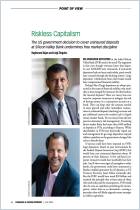
Read or listen offline
Recommendation
Moody’s, Standard & Poor’s and Fitch emerged as unexpected villains of the housing market collapse. This detailed, enlightening report from the Cato Institute provides a valuable primer on the history of the credit rating agencies and the regulatory scheme they rode to prominence. Emily McClintock Ekins and Mark A. Calabria illuminate the accomplishments and misdeeds of these agencies. Considering the free-market leanings of this think tank, their conclusions are no surprise: Don’t blame the rating agencies, Cato says. Instead, blame the regulators who gave them too much power and too little incentive to innovate. One note: If you don’t align with the Cato Institute’s conservative ideology, you might not find this report convincing. getAbstract suggests it to investors and issuers seeking perspective and insight into the world of rating agencies.
Take-Aways
About the Authors
Emily McClintock Ekins is a Cato research fellow, a PhD candidate at UCLA and director of polling at Reason Foundation. Mark A. Calabria directs financial regulation studies at the Cato Institute.




















Comment on this summary or 开始讨论